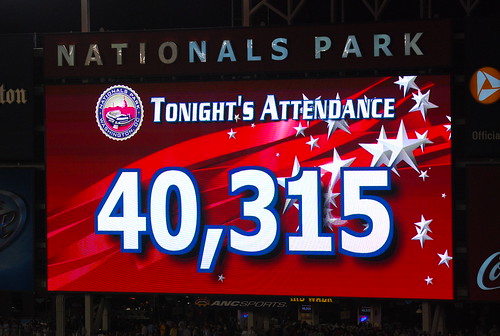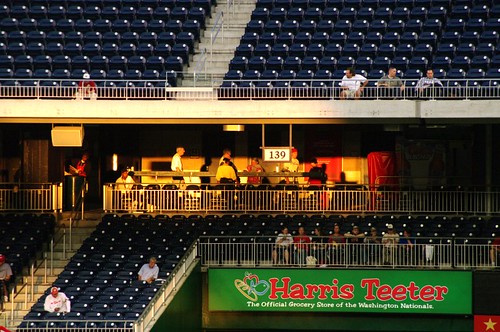
‘First pitch’
courtesy of ‘BrianMKA’
When it comes to talking about the crowds at Nationals Park, there is at least one Greek Choral reminder from the masses that the majority of fans who make their way through the gates are usually rooting for the other team. This isn’t even a new phenomenon for the Mid-Atlantic, as the central location of Washington and Baltimore amidst its other East Coast counterparts seems to draw the visitors in packs. One of the bigger culprits (assumed culprits, I should say, since the research is to come), are the Phillies, who in addition to being just 122 miles up I95 from Nationals Park have been among the National League elite now for about the last five or six years.
Within a week of a Nationals fan yelling at Braves supporters with “This Ain’t Atlanta,” the Phillies come to town to start the first of three series that they will play down by the Navy Yard. What better time to hyperanalyze attendance numbers and look around to see what we can gather about the Nationals and their opponents’ ability to draw crowds?

‘Tonight’s Attendance 40,315’
courtesy of ‘afagen’
To say this is scientific is way more than generous, and in fact, potentially offensive to people who study this for real. Thanks to Baseball Reference, I was able to get the reported game-by-game attendance figures for the Nationals (and later in this piece, the Orioles page was also quite useful). Context for all of this: the listed capacity at Nationals Park is 41,222, and in the last two full seasons, the reported attendance was at or above that number a grand total of four games. Those four games? The 2010 season opener against the Philadelphia Phillies (held on a pleasant Monday afternoon) and all three games from an 2009 interleague series against the Boston Red Sox.
That’s not disproving any myths now, is it? Let’s take it one step further and look at games where attendance peaked 40,000 to expand our sample size a bit. There were three additional games from 2010 (another interleague game, this time with the White Sox, Strasburg’s June debut against the Pirates and a late July game against Atlanta), as well as one more game from 2009, again with Philadelphia in town in what appears to be the first local match-up of the teams that season.
All the above tells me is the following: the first time the Phillies play their nine games as visitors against the Nationals, it draws a spike in the crowd. There was at least one more interesting difference between the two compared seasons: the Phillies late July series in 2010 (which was over the trading deadline, one in which they pulled Roy Oswalt into their ranks, and Strasburg was a potential starter before shoulder issues sidelined him that week) drew 30,000 or more in each of the three games. Again, I’m no statistician, but I doubt the spike above the average (22,569 or so) and mode for the season (21,625) can singly be attributed to Phillies fans – but it certainly would be a reasonable partial argument.

‘spotlight on 139’
courtesy of ‘philliefan99’
I will concede the following: when it is the opener of the season or a nice weekend in the summer, away fans may make their way to the park more than they would for other teams. The Boston series is an anomaly; an interleague series between the two clubs is likely only to happen in Washington every six years, so displaced Northerners would of course jump at the chance. I’m pretty sure that’s why interleague baseball was created, although, the Nationals didn’t exactly go out of their way to make us Sawks fans feel unwelcome.
Here’s a bit of evidence for the other argument, though: the Phillies, Mets and Braves were just as often in games that fall below the median and mode line for attendance. In 2010, there were six games featuring these three teams that drew 17,131 or less, and another seven in which the number was at the statistical center of 21,625 or less. That means in 13 of the 27 games against these three (nearly half, in laymen’s terms), the stands were less full than the norm would indicate.
Now, reading the attendance numbers blindly and trying to guess isn’t fair, completely. Perhaps there’s another phenomenon at work, though: when these other teams come to town, yes, they gather some local fans of their club. As regional and division rivals, though, perhaps Nats fans also come out a little more than usual, too.

‘110404-A-9535B-034’
courtesy of ‘Maryland National Guard’
The last part of that explanation makes for a really interesting comparison to Baltimore. Fans of the Orioles have long complained about the influx of Boston and New York fans (which add up to be further from its Inner Harbor shrine to baseball than Philly and New York to DC). A 2006 article from the Sun captures this quite nicely:
Downtown will again be transformed into a sort of Times Square or Boston Common. If you’re in earshot of any of the games, you won’t know from the cheering who just scored. It’s all very wrong, and for years now it has become depressingly routine. Still, sporting questions remain – if only to provide local fans ways to stay engaged in our imaginary rivalries with both teams:
Have Red Sox fans surpassed Yankees fans in behavioral issues at Oriole Park? In other words, are they more obnoxious? (All that Boston gear worn by all those bandwagoning Red Sox fans!) Have Yankees fans at Oriole Park toned it down a bit? Are we such a nonthreat they have grown reserved? Will Joe Torre actually play his starters?
The numbers from the last few seasons in Camden Yards show something that will make the Orange-and-Black Clad pretty upset. Just as with the Nationals, early series against the closest division rivals drew well. Looking at just last year’s numbers,the O’s sold out the 48,262-seat stadium in Inner Harbor twice, one each against Boston and New York (the latter having been the home opener). During the nine times the Sox were in town – three weekend series, which of course skews it a bit – the lowest attendance was 26,812, still 4,000 or so above the mode for the O’s in 2010. The Yankess had seven games above the mode, in addition to being right on the nose on it once. That means in 17 out of 18 games with the two clubs, the Orioles had hit or exceeded the expected number of fans. That’s an away fan takeover.
What’s the takeaway on all this geeky numberology? Go grab a curly-W hat, one of the many remaining tickets for Tuesday’s opener with the Phils and find your way down to Nationals Park. I guarantee you won’t be alone in cheering for the Nationals.
Nice piece Dave. One thing, something you know but others may not, and I’m not sure it makes a difference in what you were saying, but, attendance figures from MLB is paid attendance, not fannies in the seat. They used to provide the actual, but several years ago, they started with just giving paid attendance (much to annoyance of those of us who would like to know the actual).
Jay, excellent point and a good reminder. I tried to stick with reported figures, as well, because it takes out factors like delays and weather.
Another thing to look at is how many of those games that are above average are in April and September, when the college students are in town. I go to AU, so when I’m here I love going to games, more then often when the Phillies play, but pretty frequently to just go to a good game. So that’s another thing to consider.
Unfortunately, the question posed in the title of this post cannot be answered with the data you have. As you state (but then back away from in the second-to-last paragraph), the rise and fall of attendance could be explained in several ways: (1) increased home team fans, (2) increased away team fans, or (3) people coming out for other reasons altogether, like weather, Stephen Strasburg, quality of opposing team, convenient day/time of game, etc. Most likely, several factors contribute. The interesting question is the extent to which each factor influences attendance — the fact that there are more fans at a Nats/Phillies game than at a Nats/Marlins game kind of goes without saying.
You’d probably be better off just taking a picture of the crowd and analyzing the colors.